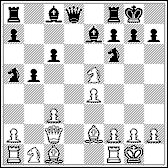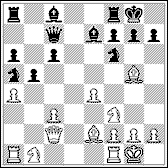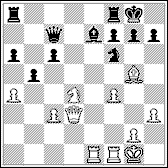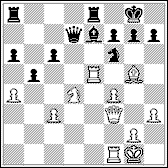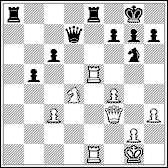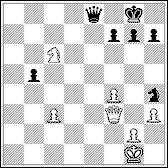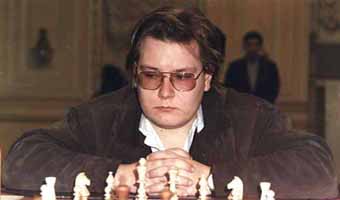
|
Konstantin Sakaev,
|
Short, Nigel (2683) - Svidler, Peter (2672)
KC Internet Grand Prix, 2000, round 2.2
[C51]
|
1. e4 e5 2. Nf3 Nc6 3. Bc4 Bc5 4. b4 Bxb4 5. c3 Be7 6. d4 Na5 7. Be2
d6
Svidler chosed the line where White's chances, in my opinion, are obviously
better. After
12...Qc7 13. f4
Here 13. Bf4! seems to be strong, for example, 13...Bd6 14. Rd1 Qc7 15. Rxd6 Qxd6 16. Ng6 Qc5 17. Nxf8
17...Qxf8 ( 17...Kxf8 18. e5 Nd5 19. Qxh7 Nxf4 20. Qh8+ Ke7 21. Qh4+ ) 18. Nd2 with advantage. By now nobody has played 13. Bf4 , usual continuations are 13. a4 and 13. Nd2 . 13...Qc7 14. Nf3 a6 15. Bg5
It is stronger than 15...Be6 16. Nbd2 Nb7 17. Nd4 Nc5 . 16. Nbd2 Nb7 17. h3 Bh5 18. Rae1 Nc5 19. Nd4 Bg6?!Looks like a mistake. Necessary was 19...Bxe2 20. Rxe2 Ne6 , or 20...h6 21. Bh4 Nh5!? 22. Bxe7 Qxe7 , and if 23. Nxc6?! , then 23...Qf6 24. Nd4 Nf4 .
Tempting was 20. Bxf6!? Bxf6 21. f4 , for example, 21...b4? 22. f5 bxc3 23. N2b3 . 20...Ncxe4 21. Nxe4 Bxe4White hardly has a sufficient compensation for a pawn. 22. Bd3 Bxd3 23. Qxd3
I would recommend 23...Nd5 . In the case of 23...Bc5 24. Bxf6 gxf6 one should expect a quick draw, but after 23...Rfe8?! White gains better chances. 24. Re5! Qd7 25. Qf3?!
If 25. Qe2 , then 25...Bc5! , that's why 25. Qg3!? deserved attention. 25. Qf3 permits 25...Nd5 . 25...Nd5 26. axb5 axb5 27. Bxe7 Nxe7 28. Rfe1 Ng6
Possible was 28...Nd5 29. Nxc6 (after 29. Qg4 Rxe5 30. Qxd7 Rxe1+ Black stands better) 29...Qxc6 30. Rxe8+ Rxe8 31. Rxe8+ Qxe8 32. Qxd5 with a draw. 29. Rxe8+ Rxe8 30. Rxe8+ Qxe8 31. Nxc6 Nh4
32. Qd5 Qe3+ 33. Kh1 Qc1+ 32. Qg4 Qxc6 33. Qxh4 f6 34. Qg3 1/2:1/2 |
|
|
Next game, annotated by K.Sakaev |
|
|
Previous game, annotated by K.Sakaev |

